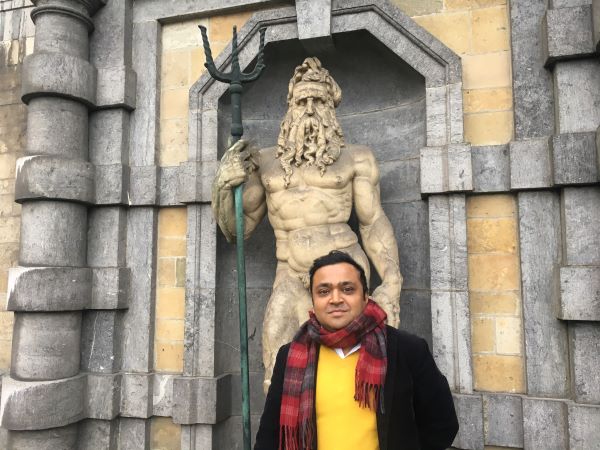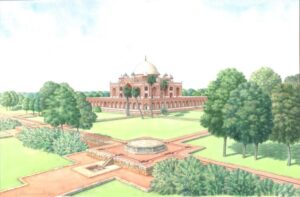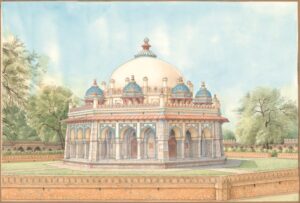Architecture & art are irreplaceable assets, should be preserved & conserved

Architect-artist Himanish Das
Rajkumari Sharma Tankha
Aga Khan Trust for Culture recently held an exhibition of 20 artworks made on the conservation effort being undertaken by it at India International Centre, New Delhi. Titled The Portraits of Conservation, these paintings illustrate views of the monuments as they were expected to appear post conservation or as they had once appeared. Life& More, spoke to the artist behind these works, Himanish Das:
Tell us more about The Portraits of Conservation.
The paintings relate to the conservation of various monuments in Delhi, including Humayun’s Tomb, Rahim’s Tomb and several other buildings in the Nizamuddin area. They illustrate views of the said monuments as they were expected to appear post conservation works or as they had once appeared. Such an active engagement by an artist to a conservation effort has never been done before. These paintings have helped inform conservation works, inform officials, donors and interested stakeholders.
There were 20 paintings in this exhibition, along with the photographs, which showed how the sites were when they were painted and how they appeared at the completion of the conservation/ landscape restoration effort. The exhibition demonstrates the inter-disciplinary nature of conservation and showcases an eclectic selection from my artistic oeuvre to enable viewers to see for themselves how an architect-artist’s vision has been harnessed to understand heritage structures and their setting.

How did you come up with these paintings? I mean sitting in London, talking to teams in Delhi over the phone – isn’t that a massive task?
These works have been done over a long period of time starting around 2007, and developed in tandem with conservation studies, research and investigation on site. They have involved hours of research and discussions with internationally reputed scholars of Mughal Art and Architecture, and other specialists.
Being a practising architect in London, I have juggled this work together with my architectural work, through these years. When you love and enjoy what you do, time is not a constraint. I have greatly enjoyed working on the conservation efforts and these paintings, and have aimed to create a repository of work for posterity, which will hopefully be available for study and research to scholars of history and art lovers.

How did AKTC connect with you?
Years ago in the late 1990’s, while I was still a student of architecture, I was commissioned by Eicher Goodearth Ltd. to do a series of architectural paintings of the built heritage of Delhi from the 12th century until the mid-20th century. This turned out to be quite a serious study and was eventually exhibited and extensively published. Ratish Nanda from the Agha Khan Trust was a great admirer of these works and invited me at the earliest opportunity, to work with them on their conservation projects, starting with some projects in Mehrauli, eventually involving Humayun’s Tomb and many other monuments in Delhi and Hyderabad.
Have you done such work earlier? If yes, please share details of those?
Apart from work done for Eicher Goodearth. I worked on a large number of architectural drawings of havelis in Jaisalmer as part of my PhD research in England. These are very detailed and intricate works of art in their own right, and I had documented these from scratch. These are currently in my private collection, and I am planning to do an exhibition on these soon.
What explains your special interest in conservation works?
I am passionate about conservation of architecture and art. I believe these are our irreplaceable assets and should be preserved for the future generations. In England, where I work, we are very conscious and particular about working with heritage buildings. Defacing them or carrying out unauthorised work to them is a criminal offence. We have often worked on refurbishing listed buildings and built adjacent to heritage buildings in various parts of the country, including an Art Gallery and museum in Canterbury, high end apartments in Surrey and Oxfordshire amongst other places.
When did you foray into the world of paintings? Is it a childhood passion or one that developed after you turned an architect?
I have painted from a very young age, being introduced very early to the art of Shantiniketan with artists such as Nandalal Bose, Abanindranath Tagore, as well as Western masters such as Rembrandt, Leonardo, Van Gogh and others.
Later, while living in London, I got to see masterpieces of Indian art, including miniature paintings which greatly inspired my art practice in many different ways. I was also drawn to Company School paintings, particularly the architectural renderings, which I found very inspirational after turning an architect. I think you can see the influences in my work, particularly in this exhibition.


